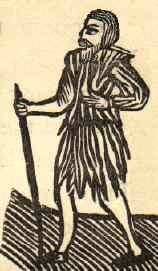"Madness in great ones . . ."
Shakespeare knew well that madness was no sport, but the result of deep mental distress. Hamlet, whether his "antic disposition" is real or feigned, is a young man under great stress; Ophelia, the good girl who obeys her father and rejects her loved one (only to find that the one kills the other), expresses her feelings the only way she can by rejecting the constraints of her society through madness*.
Lear struggles against losing his reason for much of the early part of the play. When he does succumb to mental stress, it is a sign of growth under duress that he moves from self-pity--the imagined trial of Regan--to pity for all as he inveighs against the inequities of justice.
Edgar is a special case, since he is certainly acting a part as poor Tom: he fits the popular image of the madman "possessed" by devils. The difference between a madman (like Poor Tom) and a witch was that the witch was supposed to have deliberately made a pact with the devil, whereas Tom was involuntarily possessed by devils. It is interesting that Edgar, to make his state more credible, invents a sinful past as a lecherous courtier.
Thus it was possible merely to pity, or to laugh at those possessed, whereas a witch was to be feared and reviled.
A song* about "Poor Tom".
Footnotes
-
Ophelia's madness
Recent film of Hamlet produced by Franco Zefirelli and Kenneth Branagh portray Ophelia in such a way that it is clear that her madness allows her to express herself in a way otherwise forbidden.
-
Poor Tom's a-cold
"Poor naked bedlam, Tom's a-cold, a small cut of
thy bacon or a piece of thy sow's side, good Bess.
God Almighty bless thy wits"
(Orlando Gibbons, "Street Cries").Compare Edgar, disguised as Poor Tom the "bedlam" in King Lear:
"Who gives anything to Poor Tom? Whom the foul fiend hath led through fire and through flame, through ford and whirlpool, o'er bog and quagmire. . . Bless thy five wits, Tom's a-cold" (4.4.50-57).
Listen to the passage:
